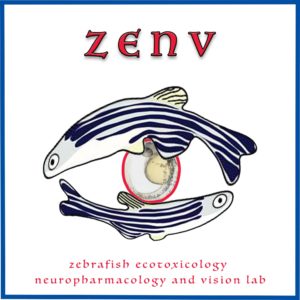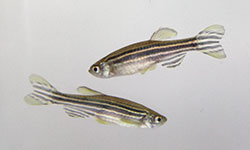 Research in our lab encompasses the disciplines of neurobiology and ecology. We are interested in how eye (retina) function and/or development is altered by the application of drugs, as a result of disease, or due to exposure to environmental contaminants. We are also interested in whether exposure to chemicals during development can have long-lasting effects evident in adults. Experiments are interdisciplinary using anatomical, physiological, and behavioral techniques. Ecological experiments focus on behaviors during the larval stage as well as factors that impact overall growth and development. This combination of techniques identifies both structural and functional changes that may occur as a result of compound/disease exposure.
Research in our lab encompasses the disciplines of neurobiology and ecology. We are interested in how eye (retina) function and/or development is altered by the application of drugs, as a result of disease, or due to exposure to environmental contaminants. We are also interested in whether exposure to chemicals during development can have long-lasting effects evident in adults. Experiments are interdisciplinary using anatomical, physiological, and behavioral techniques. Ecological experiments focus on behaviors during the larval stage as well as factors that impact overall growth and development. This combination of techniques identifies both structural and functional changes that may occur as a result of compound/disease exposure.
At this time, we have three major research foci in the lab:
- Changes due to high blood sugar (hyperglycemia) in the zebrafish Type 2 diabetes model. We developed an alternate immersion protocol for use with adult zebrafish that induces and maintains hyperglycemia for up to 12 weeks.Using this protocol, we reported that 4 weeks of exposure causes anatomical, physiological, neurochemical, and cognitive changes in adult retinal tissue. Weight loss is apparent after 8 weeks of exposure. Current experiments focus on whether cannabidiol (CBD) exposure can mitigate hyperglycemia-induced effects.

- Assessing the long-term impact of developmental exposure to endocrine disrupting compounds (EDCs) on the visual system. We exposed zebrafish larvae aged 72 hours postfertilization (hpf) or 7 days (d) pf to environmentally-relevant concentrations of bisphenol A (BPA) or tributyltin (TBT) and assess visual system effects 1-, 2-, 4-weeks later as well as 3-4 months later. BPA is an estrogenic agonist; whereas TBT is an estrogen antagonist because it blocks estrogen synthesis. Using BPA, we find early (1- and 2-weeks after exposure) behavioral differences due to BPA exposure. However, these differences are absent in adult. However, adults show physiological and neurochemical differences in retina and molecular changes in estrogen signalin pathways. TBT exposure also causes early, transient behavioral changes and later physiological effects in retina. Current work is examining (1) cross-reactivity of BPA with other hormonal targets and (2) the mechanisms involved in recovery from TBT exposure. This project is supported by an R15 AREA grant from NIH.
- Using zebrafish to assess biological health of the Anacostia River. The Anacostia River has been the focus of remediation and clean-up efforts for several decades, with recent report cards showing improvement. This, more recent project, funded by the DC Water Resources Research Institute, involves collecting water from specific sites along the Anacostia and rearing zebrafish eggs/larvae in that water within a laboratory environment. These experiments will address how early fish development occurs in/is impacted by exposure to Anacostia River water. We have performed water quality analysis on collected water samples and identified siloxanes as a major contaminant across all samples. We find that zebrafish larvae display stress-like behaviors when maintained in Anacostia River samples. Current experiments are examining (1) changes in protein and mRNA levels in treated fish and (2) effects on adult breeding.

https://info.noldus.com/topic/anxiety-research/page/2